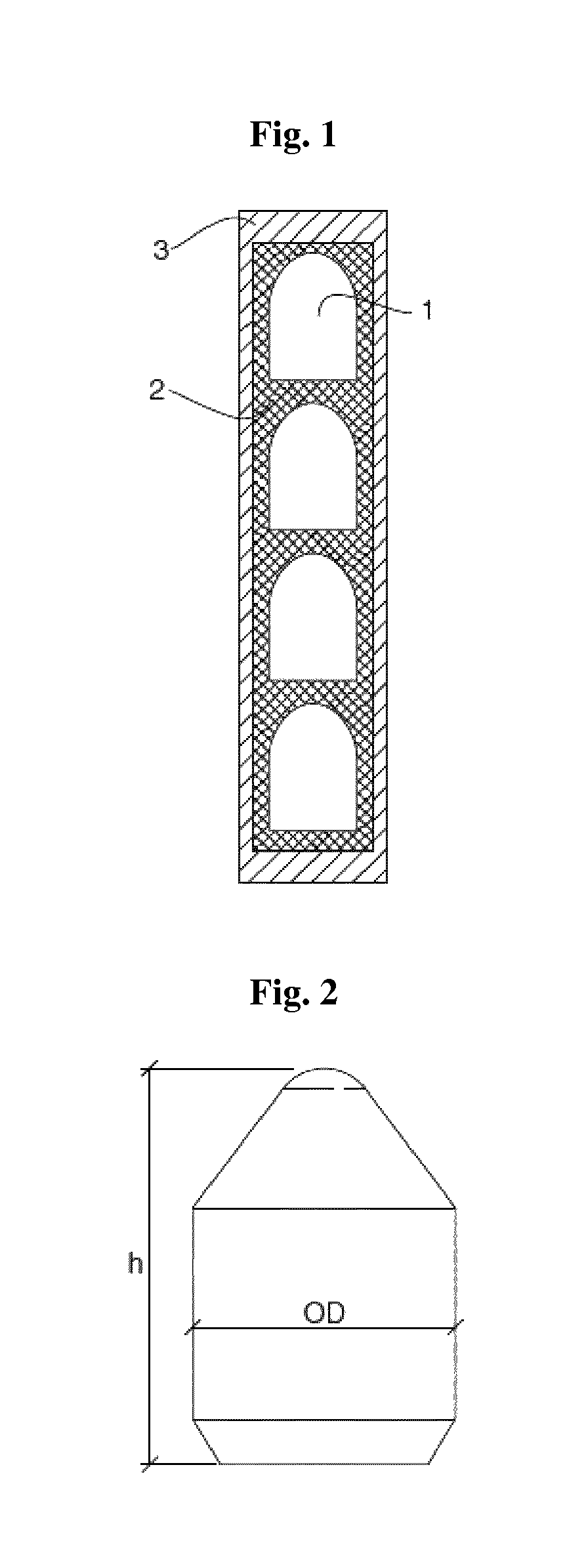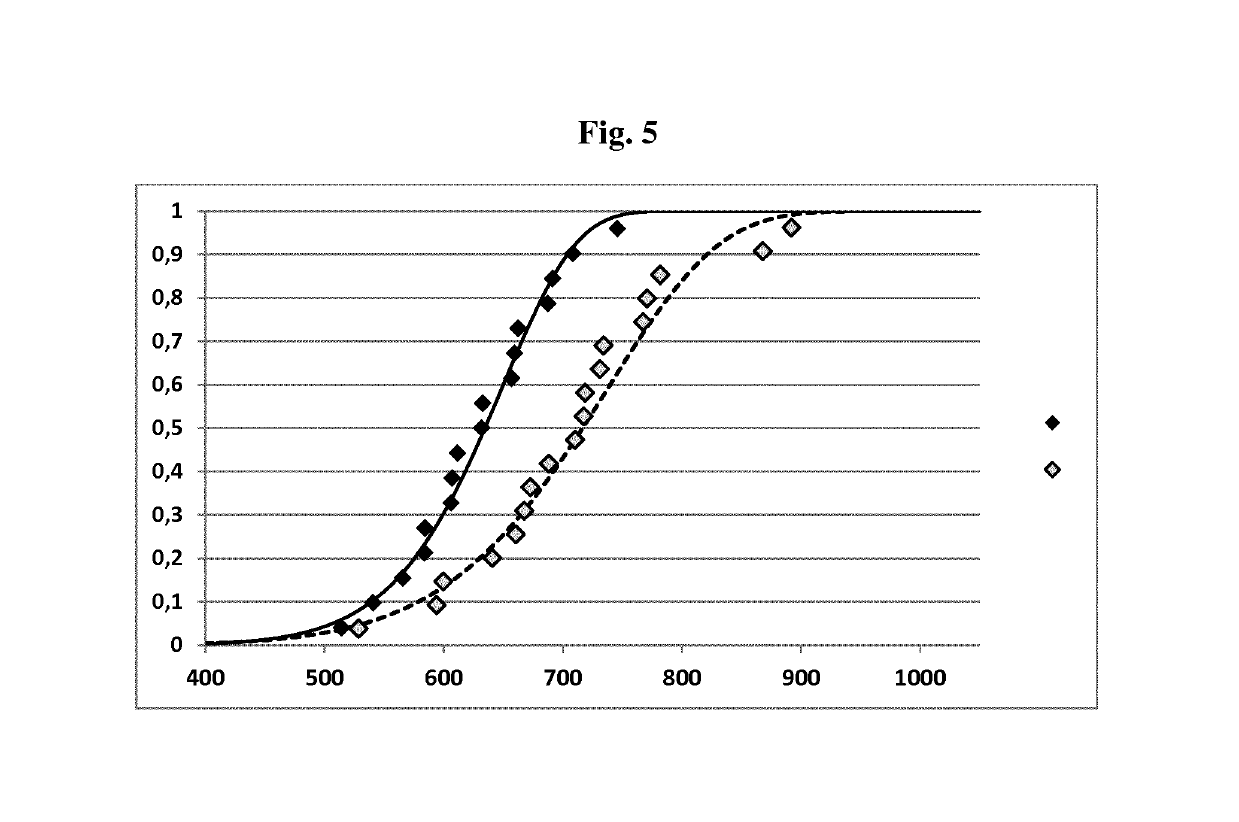Method of producing a component of a composite of diamond and a binder
a composite and diamond technology, applied in the field of producing components of composites of diamond and binder, can solve the problems of difficult to adapt to complex shaped objects in industrial applications, significant limitations in the amount and size of bodies that may be produced, etc., and achieve the effect of high relative amount of diamond and large-scale production of diamond composite components
- Summary
- Abstract
- Description
- Claims
- Application Information
AI Technical Summary
Benefits of technology
Problems solved by technology
Method used
Image
Examples
example 1
25 Bar and 1570° C.
[0051]Diamond powders were dry blended together to form a uniform mixture. The diamond was a mixture of 80 wt % 20 to 30 micron and 20 wt % 4 to 8 micron diamond of grade MBM from Diamond Innovations Inc, this diamond blend is hereafter referred to as DPSD 1. Homogenous slurry was prepared using this mixture and then adding PEG1500 and PEG4000 as temporary organic binders, with de-ionized water as the fluid. The slurry was spray granulated to produce granules for pressing and the amount of organic binders in the powder was 9.26 wt % which corresponds to 23 vol %.
[0052]Granules were used in uni-axial pressing of green bodies in the shape of tool tips (buttons) typically used in mining operations (rock drilling) to a green density as high as possible with the used compaction technique. The force applied for the compaction of the green bodies was typically 40-50 kN. The relative diamond density in the green bodies was around 60%. The relative diamond density in perce...
example 2
00 Bar and 1520° C.
[0064]Green bodies were prepared and de-bound (brown bodies) as in example 1. Also the capsule and the Si blend are the same as used in example 1. The total amount of Si added to the capsule was 36 g and the total weight of the brown bodies was 29 g. The temperature was increased to 400° C. under vacuum. After a 30 min hold time at 400° C., the argon gas pressure was raised to 40 Bar. Then the temperature was increased with 16° / min to 1300° C. At 1300 C the pressure was increased from 40 Bar to 1000 bar during 55 minutes at a constant temperature followed by a temperature increase of 11° C. / min to the maximum sintering temperature and pressure of 1520° C. and 1000 Bar. The capsules were then allowed to cool down freely with a constant pressure release. After 15 min the temperature was about 800° C. and the pressure was about 730 Bar. After 70 minutes cooling, the temperature was about 200 degrees C. and the HIP furnace was opened.
[0065]After HIP, the Zr-capsule wa...
example 3
30 Bar and 1570° C.
[0067]Diamond powders were weighed and dry blended together to form a uniform mixture according to DPSD 1. Slurry and greens were prepared as described in Example 1. Four brown bodies were placed in a Zr-capsule with a sealed bottom and with a dense packed silicon powder blend completely surrounding the brown bodies as shown in FIG. 1. The Zirconium capsule was manufactured as described in Example 1. The Si-powder blend was a mixture of 96 wt % Silgrain® coarse from Elkem with a purity of 99.5 wt % and with an oxygen content of 0.119 wt % analyzed by LECO and 4 wt % of a graphite powder with a purity of 98% and a particle size3, se table 4.
[0068]
TABLE 4SintereddensitySamplem brownm sinteredm increaseV sinteredArchimedesNo.(g)(g)(%)(cm3)(g / cm3)3a7.37811.40754.6083.2883.4963b7.56111.49251.993.2873.4963c7.46811.46553.5223.2833.4923d7.5611.47251.7463.2853.492
[0069]The dimensions (outer diameter (OD) and height (h)) of one sintered body (No 3b) was measured as shown in...
PUM
| Property | Measurement | Unit |
|---|---|---|
| temperature | aaaaa | aaaaa |
| temperature | aaaaa | aaaaa |
| pressure-temperature | aaaaa | aaaaa |
Abstract
Description
Claims
Application Information
 Login to View More
Login to View More - R&D
- Intellectual Property
- Life Sciences
- Materials
- Tech Scout
- Unparalleled Data Quality
- Higher Quality Content
- 60% Fewer Hallucinations
Browse by: Latest US Patents, China's latest patents, Technical Efficacy Thesaurus, Application Domain, Technology Topic, Popular Technical Reports.
© 2025 PatSnap. All rights reserved.Legal|Privacy policy|Modern Slavery Act Transparency Statement|Sitemap|About US| Contact US: help@patsnap.com



